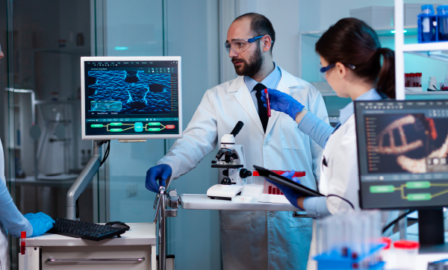BIO 2018: Five Lessons Learned
2018 marked the 25th anniversary of the Biotechnology International Convention (BIO 2018). The annual convention was fittingly held in Boston, Massachusetts, a hub for biotechnology innovation. Industry leaders and changemakers from around the world came together to share perspectives on where the industry is headed. “Make History” was the foundational theme which was the core of many sessions throughout the convention.
We found that at the forefront of leadership agendas in the biotechnology space was to make history through innovative and patient-focused medical breakthroughs. We are seeing now more than ever a shift towards collaborative efforts between scientific research organizations and also throughout the value chain. Partnering will continue to be the driving force that enables greater patient access, technology-enabled solutions, and policy changes that impact every player in the industry from the lab to the patient.
BIO 2018 Lesson 1: Partner Across the Value Chain to Achieve Breakthrough Innovation
Tradition tells us that collaboration across the value chain has not been a priority. Each stakeholder operates through a different business model and has their own motivations for success in the primarily transactional relationship. We now see the industry trending towards more partnerships specifically with technology-enabled and patient-centered design solutions. Albert Bourla, Chief Operating Officer of Pfizer, discussed his belief that “technology is redefining the relationships between different stakeholders of the marketplace.” The shift in business models from volume-based to value-based is inspiring the need for partnerships focused on realized value.
Example: Amgen’s L.A.U.N.C.H (Linking & Amplifying User-Centered Networks through Connected Health) Program
Amgen joined a cross-functional collaboration effort to improve cancer patient outcomes. The program will employ human-centered design techniques to focus on the needs of patients, caregivers, and healthcare providers. This partnership includes the National Cancer Institute (NCI), the Federal Communications Commission (FCC) Connect2Health Task Force, the University of Kentucky Markey Cancer Center and the University of California, San Diego (UCSD) Design lab.
Peter Juhn, M.D., VP of Global Value-Based Partnerships at Amgen, spoke to the need for rethinking challenges in all facets of the patient journey. Specifically, he encouraged stakeholders to focus on innovation, affordability, and accessibility. Partnerships help all stakeholders involved share risks and keep the goal of providing value in mind rather than completing transactions.
BIO 2018 Lesson 2: Bridge the Communication Gap to Enable Value-Based Care
The premise for forming partnerships is grounded with the goal of providing value through patient access and affordability. To provide such value, leading biotechnology organizations are putting patient-centricity first by communicating their transparency. Communicating value to all players is successful when an organization exhibits patient-centric values and culture. There are many patient-centric initiatives such as providing education services, patient advocacy groups, and training programs that provide value through communication and involvement.
Example: Alnylam Pharmaceuticals’ Patient Access Philosophy:
Barry Greene, President of Alnylam Pharmaceuticals, shared his long-standing belief in proactively offering value-based agreements. In the fifteen years of drug development for Patisiran, Alnylam communicated early and often with both patients and physicians to understand the disease and develop a solution that provided value to patient needs. Alnylam’s patient access philosophy clearly states their investment in proactively providing surrounding stakeholders in healthcare with value.
BIO 2018 Lesson 3: Give Patients a Voice before Bringing Solutions to Market
Patient Advocates shared their unique perspectives on the healthcare system through a panel discussion where the key theme was health education to patients, caregivers, and healthcare providers given the complex nature of diseases and the healthcare system. Despite advances in innovative medicines such as CAR-T therapies, genome-sequencing, and personalized medicine, there are major challenges surrounding patients and their level of interactions with stakeholders in the healthcare industry. The industry has a long way to go before scaling solutions to reach patients when and where they need treatment.
Before going after clinical outcomes, it is important to keep in mind:
- How can a treatment make it easier for patients?
- How can a treatment give patients peace of mind?
- How can a treatment build trust with patients?
There is a need for greater diversity and inclusion of patients during the drug development stages all the way through disease management. Involving patients early and often in the process will not only lead to more pointed clinical solutions, but it will also build trust and patient engagement, which is crucial for achieving medical breakthroughs and succeeding in bringing a drug to market.
BIO 2018 Lesson 4: Digital Medicines – A New Product Category
After drug product launch, the efficacy and safety of drugs are monitored and developed based on patient outcomes. In the case of digitally-enabled medicine, there is an opportunity to monitor data-driven outcomes and develop several iterations similar to technology launches such as Apple products. Evolving technology solutions call for multiple iterations to improve quality and efficacy measures. Don Jones, the Chief Digital Officer for Scripps Translational Science Institute, shared the opportunity for digital medicines to act as a new product category that will disrupt the market. Imagine a patient and their healthcare provider had the ability to understand their disease through real-time data that connected to wearable technology. A full-service digital health offering can help set a new drug to market apart from the rest of the competition by providing connected offerings in addition to a life-saving drug. When considering digital solutions, organizations should understand how the digital strategy fits in with their current processes to ensure seamless integration.
Example: Otsuka and Proteus Digital Health Partnership
The “Internet of Connected Medical Things” became a reality for Otsuka and Proteus who brought the first digital health technology solution, Abilify MyCite, through FDA approval in November 2017. The drug is a combination of two independently FDA-approved solutions with the added benefit of a merged digital and medical solution. According to Timothy Peters-Strickland, Senior Director, Global Clinical Development at Otsuka Pharmaceuticals, one challenge Otsuka now faces is how to demonstrate value to payers when securing value-based agreements, which has led to data-focused phase IV trials. The challenge of communicating value from digital medicines to patients is still prevalent. Despite a delayed launch, we see the importance of an iterative approach to digital medicines in achieving the highest-quality, evidence-based version.
Example: Novartis and Pear Therapeutics Partnership
In March, Novartis partnered with Pear Therapeutics to develop prescription software applications that treat patients with schizophrenia and multiple sclerosis. The goal of this partnership is to advance Novartis’ ability to track results in real-time and gather critical data to support the efficacy of their drugs. The two organizations aim to gain FDA approval of their digital solution that monitors patient data in real-time, improves patient adherence, and moreover improves treatment outcomes. Leveraging digital will go beyond the pill to enable data-driven processes that will provide greater access for patients, said Jeremy Sohn, VP and Global Head of Digital Business Development and Licensing at Novartis.
Otsuka and Novartis serve as examples of two large organizations partnering with smaller, technology-focused firms. We will see that it is no longer enough to just create a device or to just create a therapy. The industry will continue to shift towards partnerships focused on driving innovative, patient-centric solutions backed by data.
Example: Medtronic and Canary Health Partnership
In an effort to provide a holistic solution to diabetes management, Medtronic partnered with Canary Health to develop digitally enabled self-management programs. This collaboration serves as an example of coupling healthcare digital solutions with devices that improve disease management for patients. While Medtronic is focused on developing medical devices, Canary Health supports the consumer front-end operations to support patient needs around digital inquiries. Medtronic has put value-based care at the forefront of their agenda by providing such self-management programs that enable patients to learn how to better manage their disease. In the future, we will see more partnerships that work towards bringing greater access to holistic solutions to patients around the world.
BIO 2018 Lesson 5: Advances in Machine Learning and Artificial Intelligence Require Focused Data Integration
Machine learning, artificial intelligence, and big data were consistent buzzwords across many stakeholders in healthcare. While AI technology continues to make major breakthroughs, machines can’t do it all if we want to achieve patient access. Because artificial intelligence is still an emerging technology, it is difficult to trust the integrity and value of data without healthcare professionals interpreting and extracting insights.
Example: Roche and Flatiron Health Partnership
In February, Roche acquired Flatiron Health for its oncology-specific electronic health record (EHR) platform enabled by software that gathers data to reveal cancer-related insights. Despite increased adoption of electronic health records, there are still gaps in gathering and interpreting the data efficiently. For example, why can’t a healthcare professional google for answers through an EHR database? This partnership is just one of many that Flatiron hopes to make as they pursue their mission to connect stakeholders through data aggregation and integration.
Thinking back to the need for partnerships, advances in artificial intelligence cannot be completed in silos. Both data scientists and healthcare specialists need to be in the same room to understand the data and trust the machine. With increased data collection comes the rising concern of data integrity. Currently, there is a major difference between the regulatory landscape and the technology landscape in healthcare. If an organization wants to see the benefits of AI sooner, they need to include technology, regulatory, and healthcare experts early in the process to ensure diligent validation of the machine solution.
As the traditional healthcare landscape continues to change, patient-centric stakeholder partnerships will disrupt the way we think of drug product, technology, and patient access solutions.
Co-author and contributions by Lorraine Mackiewicz



